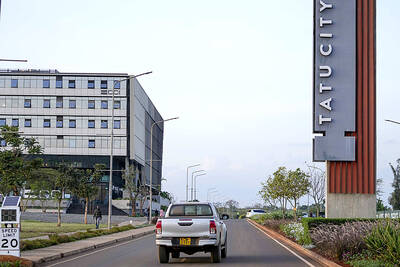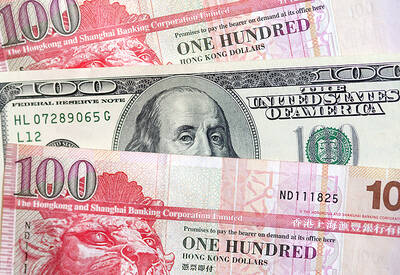PHARMACEUTICALS
Lotus upgrades facility
Generic drugmaker Lotus Pharmaceuticals Co (美時化學製藥) yesterday announced that it has begun upgrading its manufacturing facility in Nantou County to expand the production of oral oncology products. The upgrade is expected to be completed in five years and cost tens of millions of US dollars, the company said, adding that its board has approved capital expenditure of US$11 million for this year. The Nantou site has been audited by local, US, EU and Japanese regulatory authorities, enabling it to manufacture products for nearly every market in the world, the firm said. In addition to standard solid oral dose manufacturing, the company can produce hormonal products, soft gelatin capsules, and cytotoxic and high-potency molecules, it said.
TECHNOLOGY
Health2Sync launches app
Taipei-based Health2Sync (慧康生活科技) yesterday launched HealthPass, an app that grants its users full control of their health data using blockchain technology. The start-up teamed up with Bitmark Inc, a Taipei-based blockchain developer, to register users’ health data as their personal digital property. Users would be able to selectively allow certain companies and services to access their health data as part of a monetization scheme. The start-up has also tapped CTBC Bank (中信銀行) to use the lender’s blockchain-based solution to enable transactions resulting from monetization. With the help of health data analysis, insurers would be able to create tailored products based on each user’s health, the firm said.
PHARMACEUTICALS
Pharmally sales up 20.27%
Pharmally International Holding Co (康友製藥), a maker of large-volume parenteral solutions for vaccines and intravenous medicines, yesterday announced that net income last year rose 17.44 percent year-on-year to NT$1.1 billion (US$35.59 million), or earnings per share of NT$14.29, while sales rose 20.27 percent to NT$5.18 billion. Pharmally shares closed unchanged at NT$214 in Taipei trading yesterday. The shares last year saw a spike in volatility, surging to more than NT$500 on progress made at its Indonesian poultry vaccine production plant, before falling below NT$140 after a filing revealed that company officials were trimming their holdings.
ELECTRONICS
Pegatron revenue slumps
Pegatron Corp (和碩) on Monday reported that revenue last month dropped 33.4 percent month-on-month, but rose 6.2 percent year-on-year to NT$81.65 billion. Revenue in the first two months rose 3.2 percent year-on-year to NT$204.28 billion, it said. The Jakarta Post reported that Pegatron’s new plant in Indonesia is expected to begin operations next month. Separately, Lite-On Technology Corp (光寶科技) on Monday reported that revenue last month declined 30.33 percent month-on-month and 16.6 percent year-on-year to NT$10.87 billion. Revenue in the first two months also fell 10.36 percent to NT$26.48 billion.
ELECTRONICS
Chungwa Picture shares fall
A plan to lay off 2,500 employees sent shares in Chunghwa Picture Tubes Ltd (華映) into a tailspin yesterday, dealers said. The heavy selling emerged after the Taiwan Stock Exchange said that the financially troubled panel maker, which has filed for bankruptcy protection, would have to delist regardless of whether the restructuring plan is approved by the courts. Shares fell by the daily limit of 10 percent to close at NT$0.54.

To many, Tatu City on the outskirts of Nairobi looks like a success. The first city entirely built by a private company to be operational in east Africa, with about 25,000 people living and working there, it accounts for about two-thirds of all foreign investment in Kenya. Its low-tax status has attracted more than 100 businesses including Heineken, coffee brand Dormans, and the biggest call-center and cold-chain transport firms in the region. However, to some local politicians, Tatu City has looked more like a target for extortion. A parade of governors have demanded land worth millions of dollars in exchange

Hong Kong authorities ramped up sales of the local dollar as the greenback’s slide threatened the foreign-exchange peg. The Hong Kong Monetary Authority (HKMA) sold a record HK$60.5 billion (US$7.8 billion) of the city’s currency, according to an alert sent on its Bloomberg page yesterday in Asia, after it tested the upper end of its trading band. That added to the HK$56.1 billion of sales versus the greenback since Friday. The rapid intervention signals efforts from the city’s authorities to limit the local currency’s moves within its HK$7.75 to HK$7.85 per US dollar trading band. Heavy sales of the local dollar by

Taiwan Semiconductor Manufacturing Co’s (TSMC, 台積電) revenue jumped 48 percent last month, underscoring how electronics firms scrambled to acquire essential components before global tariffs took effect. The main chipmaker for Apple Inc and Nvidia Corp reported monthly sales of NT$349.6 billion (US$11.6 billion). That compares with the average analysts’ estimate for a 38 percent rise in second-quarter revenue. US President Donald Trump’s trade war is prompting economists to retool GDP forecasts worldwide, casting doubt over the outlook for everything from iPhone demand to computing and datacenter construction. However, TSMC — a barometer for global tech spending given its central role in the

An Indonesian animated movie is smashing regional box office records and could be set for wider success as it prepares to open beyond the Southeast Asian archipelago’s silver screens. Jumbo — a film based on the adventures of main character, Don, a large orphaned Indonesian boy facing bullying at school — last month became the highest-grossing Southeast Asian animated film, raking in more than US$8 million. Released at the end of March to coincide with the Eid holidays after the Islamic fasting month of Ramadan, the movie has hit 8 million ticket sales, the third-highest in Indonesian cinema history, Film